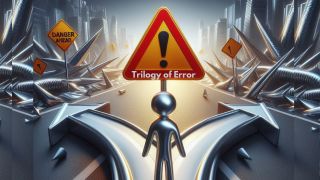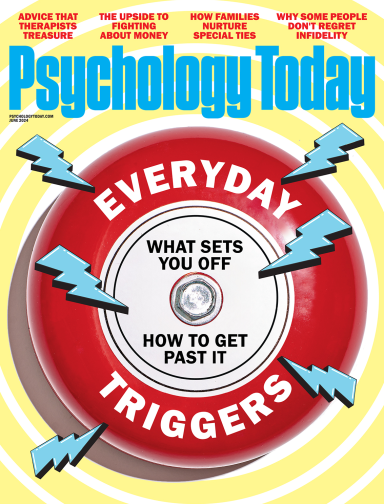Bias
The Trilogy of Errors: Hidden Influences on Your Decisions
How psychologically blind, deaf, and dumb spots can unexpectedly derail judgment.
Updated April 30, 2024 Reviewed by Ray Parker
Key points
- While most people know about blind spots, fewer realize the destructive power of deaf or dumb spots.
- These biases are equally lethal to the unsuspecting mind.
- Awareness of the trilogy of errors is the first step to more intelligent decisions.

While bias blind spots are familiar to most people, deaf spots and dumb spots are probably less so. Yet, they are equally powerful forces on our perception, communication, and decision-making.
In 1969, psychoanalyst Rudolf Ekstein proposed integrating observation with patient dialogue to enhance decision-making. He identified blind spots (inability to see a problem), deaf spots (inability to hear accurately), and dumb spots (inability to speak openly) as key areas of consideration.
These elements form what I refer to as the "trilogy of errors," leading to significant human errors ranging from wrongful convictions to missed terrorist warnings to medical errors to financial scams. It's a long list.
In my book, TUNE IN: How to Make Smarter Decisions in a Noisy World, I outline three fundamental assumptions: what you see is not all there is, what you hear is not all there is, and what you say is not all there is.
Let’s explore blind spots.
1. Blind Spots
We interpret situations based on personality, beliefs, culture, context, and companions. Recognizing and understanding these factors helps explain past behavior and mitigate future errors.
Nobel laureate Richard Thaler underscores the impact of “supposedly irrelevant factors.” He argues that irrational factors like norms, emotion, or even the weather can subtly influence what we consume, what we read, who we follow, or when we invest. For example, you may be more critical because you’re hungry or spend more because it’s sunny out. These influences are insidious.
Many individuals deny their biases, with studies indicating that 90% of people think they’re less susceptible to bias than the average person.
Nobel laureate Daniel Kahneman’s concept of “what-you-see-is-all-there-is” or WYSIATI highlights the tendency to focus narrowly on what you know, which is, in turn, based on what you perceive or experience. It’s like seeing the tree but not the forest. It’s a form of bounded rationality or inattentional blindness caused by focusing on details and trusting what we see, not what we hear.
This was exemplified during World War II. The British press covered RAF test pilot John “Cats Eyes” Cunningham, whose exceptional record destroyed enemy aircraft at night. The media explained his nocturnal vision with pictures of him wearing sunglasses indoors and eating carrots. But his aircraft was carrying airborne interception radar. The Germans believed what they saw. It’s the same with what you hear.
2. Deaf Spots
Consider a Bing Crosby study where Dutch researchers told participants that a recording of white noise contained parts of the song White Christmas. Participants were instructed to press a button as soon as they heard it. Surprisingly, a third of those listening pressed the button. However, the recording contained no such music. What explains this? They expected to hear it. Apparently, mild hallucinations are common under stress, raising questions about the impact of noise on our minds.
Inattentional deafness. Akin to its visual counterpart, inattentional blindness further complicates our perception of reality. Our fixation on Instagram-type visual stimuli can render us "deaf" to auditory cues, sparking dangerous consequences. Often, you don’t hear something because your attention is fixed. Our visual focus renders us deaf as sound and vision share limited resources. For example, you mightn’t hear the alarm if you’re focused on a Netflix movie. In a visual world, house alarms, crying babies, and barking dogs fade into the background.
Inattentional deafness is related to the concept of deaf ear syndrome, which is exacerbated by biases such as the default to truth and confirmation bias, particularly in emotionally charged situations. We may hear what we hope to be true, deny unpleasant truths, or judge messages based on the messenger.
Blind and deaf spots, along with dumb spots, where individuals remain silent due to fear or social pressures, contribute to a trilogy of errors in judgment. If people self-silence, you can’t hear their voices.
3. Dumb Spots
I heard a 15th-century English proverb growing up: “Children should be seen and not heard.” This would be unheard of today. Does this underpin our inability or unwillingness to speak out? Thousands of children abused by Catholic priests either self-silenced or were silenced by authority figures. Many victims didn’t speak out until years later.
People stay silent in various ways. Ghosting candidates, colleagues, or dates are unprofessional and unkind and often backfires.
In the workplace, dumb spots proliferate where employees maintain silence in the face of misconduct. In my own whistleblowing research, 91% of outraged employees declared an intention to speak up following exposure to a hypothetical bullying scenario. Yet shortly after, only 9% clicked a website for instructions. Firms like Theranos, FTX, Volkswagen, Boeing, and many more paid the price of complicit silence.
People tune out. There is truth in the statement by U.S. statesman Frederick Douglass: “To suppress free speech is a double wrong. It violates the rights of the hearer as well as those of the speaker."
A 3D Perspective
In essence, the trilogy of errors underscores the complexity of human perception, communication, and decision-making. It's clear that what you see is not all there is; what you hear is not all there is, and what you say is not all there is.
Nevertheless, by tuning in to others and rebalancing what we see with what we hear, we can achieve better judgment in personal and professional settings. Many solutions exist to address this trilogy, and scientists and researchers have well-documented them. It's time to tune in.




